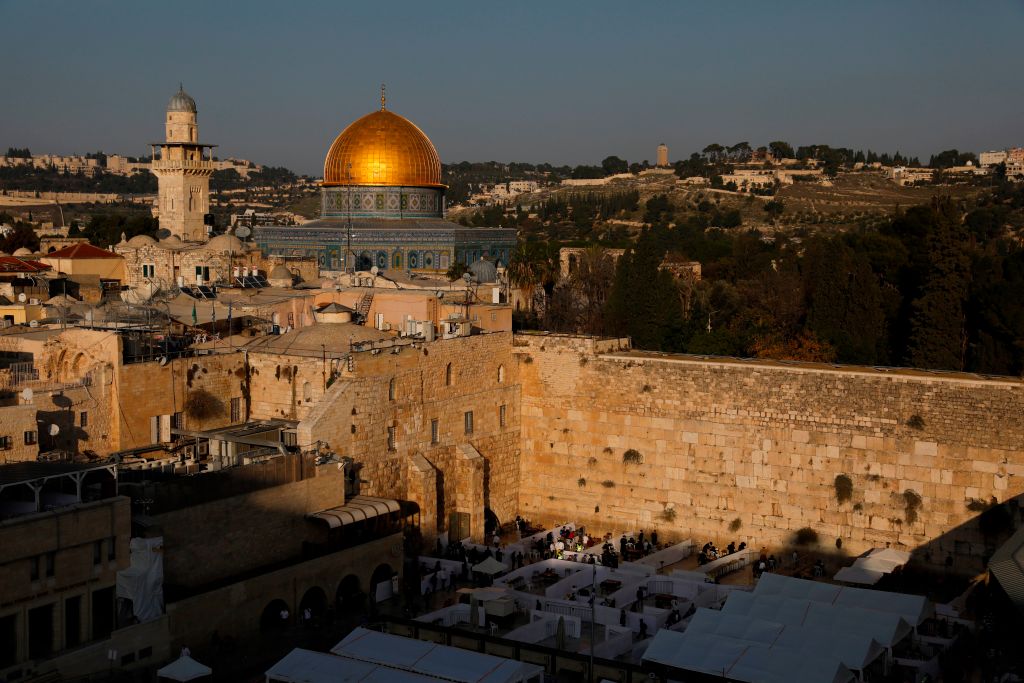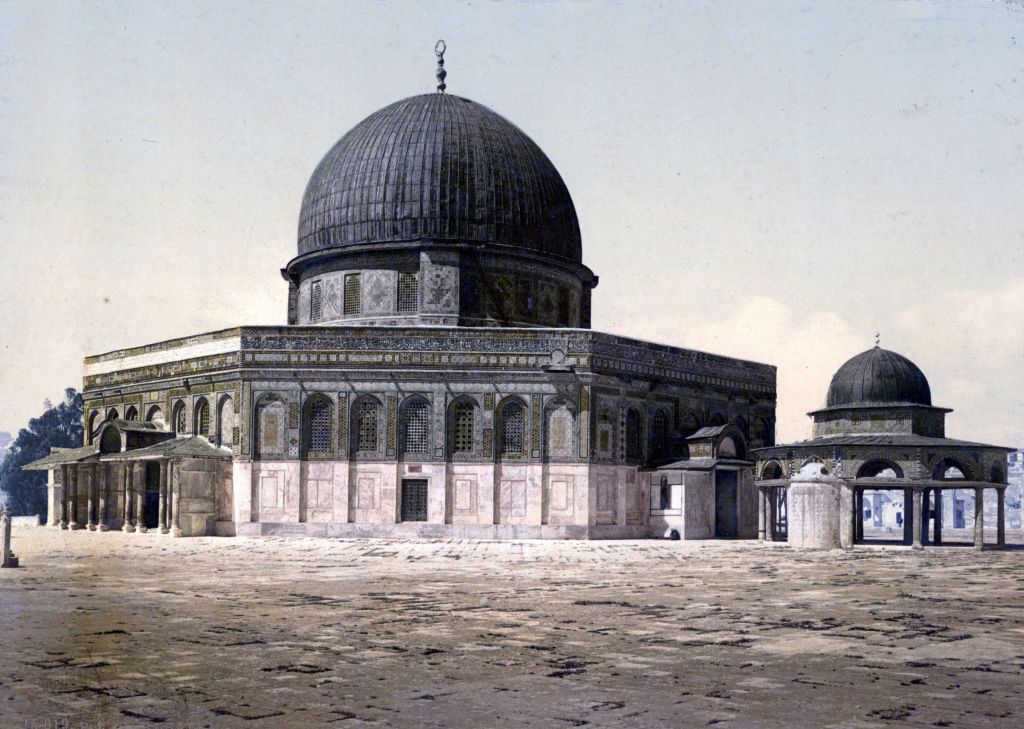
When an Israeli court ruled last month that Jews could pray on the Temple Mount in Jerusalem—if it was done quietly—the surprise decision seemed sure to spark yet another round of unrest in a city that in May endured some of its worst violence in years. Palestinians and the governments of Turkey and Egypt immediately condemned a decision that devout Jews hailed as a victory for religious freedom. A judge then quickly reimposed the longstanding prayer ban, narrowly averting an international crisis.
The trouble began on Yom Kippur, when a Jewish man engaged in prayer on the city’s 37-acre ancient acropolis that Muslims call the Noble Sanctuary, or Haram al-Sharif. Israeli police, who are in charge of security at Islam’s third holiest site, ordered him to stop. Preventing Jewish prayer at a place Judaism also holds sacred might seem a peculiar job for Israeli police, and their decision to eject the man might appear a blatant restriction of a basic human right. But to understand this prohibition, and why this religious complex is at the heart of the Israeli-Palestinian conflict, you have to dig deeper—literally.
Few realize that the roots of strife here lie not with Jews or Muslims, but in the actions of zealous European and American Christians eager to unearth the biblical past. Starting in the mid-19th century, Western explorers descended on Jerusalem, then part of the Ottoman Empire, to probe beneath the largely medieval city to find the tomb of David, the treasures of Solomon, and the true site of Jesus’s crucifixion.
This era began when a French senator in 1863 dug up a sarcophagus with bones that he claimed were those of an ancient Judean queen. The move enraged the Jewish community. “Even the Muslims are upset because of this wickedness,” a Hebrew-language newspaper reported. With the permission of the Ottoman governor, the stone casket and human remains were nevertheless shipped to the Louvre.
Not willing to be bested by Catholic France, British Protestants in 1864 launched their own campaign to retrieve biblical artifacts. A British army officer named Charles Warren even resorted to gunpowder to blast his way through the caves and cellars that honeycomb Jerusalem’s subterranean world. Since many of his activities took place adjacent to the Noble Sanctuary, some suspected the British had a secret plan to bring down the walls supporting the 1400-year-old Dome of the Rock and al-Aqsa Mosque.
Read more: How a Palestinian Uprising Against Israeli Forced Evictions Spiraled Rapidly Toward ‘Full-Scale War’
For the next half century, as the Ottoman Empire began to fray, European explorers competed to find remnants of the biblical period below, while their nations competed to control the city above. Their ultimate Holy Grail, however, remained strictly off limits. Christian excavators yearned to dig beneath the acropolis for remnants of the last Jewish temple, destroyed by the Romans in 70 C.E. (common era). Even Kaiser Wilhelm II was rebuffed when he made a personal plea to the Muslim mufti during an 1898 visit.
A decade later, a British aristocrat launched what may have been the world’s oddest archaeological expedition. He led a band that included a Swiss psychic, a French monk, a Finnish poet and a former Congo River steamboat captain on a quest to find the Ark of the Covenant. They believed the gilded box described in the Bible lay hidden in a tunnel close to the Noble Sanctuary. American industrialists and British nobles funded the effort, while senior Ottoman officials were assured of a cut in the sale of the treasure. When the team failed to uncover anything of value, its leader resorted to bribery to dig at night beneath the Dome of the Rock.

Discovered as they chipped away at the rock—long venerated as the place where Muhammad set off on a heavenly night journey—the Europeans fled. Riots ensued and protests spread across the Islamic world. The incident demonstrated that the sanctuary was revered by Muslims as far away as India, noted Brooklyn College historian Louis Fishman. “It also made clear,” he added, “that Palestinians saw themselves as having a special responsibility for protecting it.”
Just as Jewish refugees from European pogroms were turning the nearby Wailing Wall into a center of nationalist aspirations as well as religious longing, so did the Noble Sanctuary transform from a place of worship into a key symbol of Palestinian pride.
After the British marched into Jerusalem in 1917, displacing the Ottomans, a French archeologist relished “cutting into the old paving, hewing galleries and trenches” of the acropolis in order to recover bits of the ancient Jewish temple. Mindful of the millions of Muslims within their empire—particularly in nearby Egypt—British politicians forbade Jewish or Christian worship or excavations at the site. Any such encroachment, warned British diplomat Mark Sykes, would “kindle a fire which might blaze from Alexandria to Aswan.” Jerusalem, he warned, had become “inflammable ground where a careless word or gesture might set half a continent aflame.”
In the century since, little has changed. When Israel captured the Old City from Jordan in the 1967 Six Day War, Israeli Defense Minister Moshe Dayan granted Muslim clerics continued religious authority under the watchful eye of Israeli security. Like Sykes, he concluded that taking unilateral control could trigger a far more devastating conflict.
Read more: The Battle for Jerusalem
All Israeli governments since have upheld that position, yet threats to the site’s integrity have not ceased. Forty years ago, a rabbi penetrated beneath it on his own quest to find the Ark, while several subsequent efforts by Jewish extremists to destroy the Dome of the Rock were thwarted. A quarter century ago, the opening of a new exit to a tunnel extending the length of the Western Wall beneath the Muslim Quarter sparked violence that left some 100 dead and thousands injured.
Ultimately, it was the dispute over who owns the acropolis, and what lies beneath and around it, that led to the ultimate collapse of peace talks and the start of the last Palestinian Intifada, or uprising, in the early 2000s. In the two decades since, fundamentalist Christians and Jews, and even some Israeli government officials, have been increasingly outspoken in calling for a Jewish temple to be built on the acropolis, even as police have taken a softer line with Jews who enter the Muslim compound as tourists but then proceed to pray. Little wonder that “al-Aqsa is in danger” is a powerful rallying cry for Palestinians and for Muslims around the world.
Today, talk of religious freedom ignores the facts on the ground. Western Christians primed Muslims to feel that their sanctuary was under siege, and that feeling is stronger than ever. Short of using blunt force, sharing is not an option. You can hear the echo of Sykes and Dayan in the plea to the court made last month by Israel’s police minister, Omer Barlev: “A change in the existing status quo will endanger public peace and could cause a flare-up,” he warned. A full century of bitter experience has shown this to be true. The court bowed to this reality and reaffirmed the prayer ban, though the debate is sure to continue.
Until members of Jerusalem’s fractious faiths—including Christians—accept and respect one another’s existing prayer spaces, there is little chance for untying the world’s ultimate geopolitical knot. That monumental task must be left for later, braver generations. In the meantime, the imperfect and inadequate status quo is all that stands between a fragile peace and more blood in the streets of the Holy City.

Andrew Lawler is an American journalist and author. His latest book, Under Jerusalem: The Buried History of the World’s Most Contested City, is available now from Doubleday.
More Must-Reads From TIME
- Dua Lipa Manifested All of This
- Exclusive: Google Workers Revolt Over $1.2 Billion Contract With Israel
- Stop Looking for Your Forever Home
- The Sympathizer Counters 50 Years of Hollywood Vietnam War Narratives
- The Bliss of Seeing the Eclipse From Cleveland
- Hormonal Birth Control Doesn’t Deserve Its Bad Reputation
- The Best TV Shows to Watch on Peacock
- Want Weekly Recs on What to Watch, Read, and More? Sign Up for Worth Your Time
Contact us at letters@time.com